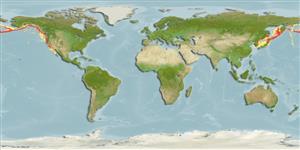Environment: milieu / climate zone / depth range / distribution range
Ecologie
marien bathydemersaal; diepte 50 - 2453 m (Ref. 123358), usually 500 - 700 m (Ref. 56456). Deep-water
North Pacific: Bering Sea to off San Diego in California, USA.
Grootte / Gewicht / Leeftijd
Maturity: Lm ? range ? - ? cm
Max length : 54.0 cm TL mannelijk / geslacht onbekend; (Ref. 80637); common length : 36.0 cm TL mannelijk / geslacht onbekend; (Ref. 56456); max. gepubliceerd gewicht: 1.7 kg (Ref. 56456); max. gerapporteerde leeftijd: 8 Jaren (Ref. 56456)
Korte beschrijving
Determinatiesleutels | Morfologie | Morfometrie
Dorsale stekels (totaal) : 0; Dorsale zachte stralen (totaal) : 54 - 58; Anale stekels: 0; Anale zachte stralen: 37 - 50. Dorsal fin extending about halfway along length of caudal fin; caudal narrow, slightly rounded; lower 6 rays of pectorals slightly thickened and completely exserted, the next 5 greatly to moderately exserted and longer than the rays immediately above them, no real notch in fin; pelvic fins modified to form a small adhesive disc with a thickened margin, placed far forward, below eye (Ref. 6885). Off-white to pale rose on body; ends of pectoral and edges of posterior parts of dorsal and anal, and most of the caudal, black; lining of mouth and gill cavity, and tongue black (Ref. 6885).
Found on mud bottoms (Ref. 2850). Possibly the most commonly captured liparid below 200 m; captured frequently by fishers (Ref. 26773). Known to feed on polychaete worms, small crustaceans, tiny clams and other invertebrates (Ref. 4525).
Levenscyclus en paargedrag
Maturiteit | Voortplanting | Paaien | Eieren | Fecunditeit | Larven
Eschmeyer, W.N., E.S. Herald and H. Hammann, 1983. A field guide to Pacific coast fishes of North America. Boston (MA, USA): Houghton Mifflin Company. xii+336 p. (Ref. 2850)
Status op de Rode Lijst van het IUCN (Ref. 130435: Version 2024-2)
Gevaar voor de mens
Harmless
Gebruik door de mens
Visserij: van geen belang
Tools
Speciale rapporten
Download XML
Internetbronnen
Estimates based on models
Preferred temperature (Ref.
123201): 0.4 - 5.2, mean 3.2 °C (based on 67 cells).
Fylogenetische diversiteitsindex (Ref.
82804): PD
50 = 0.5000 [Uniqueness, from 0.5 = low to 2.0 = high].
Bayesian length-weight: a=0.00468 (0.00278 - 0.00786), b=3.23 (3.08 - 3.38), in cm total length, based on LWR estimates for this species & Genus-body shape (Ref.
93245).
Trofisch niveau (Ref.
69278): 3.4 ±0.47 se; based on food items.
Weerstandsvermogen (Ref.
120179): Gemiddeld, minimale populatieverdubbelingstijd 1,4-4,4 jaar (Assuming tmax>3).
Fishing Vulnerability (Ref.
59153): Moderate vulnerability (42 of 100).
